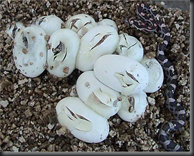
 Scientists are confounded after discovering virgin viper births occurring both in the wild and in captivity.
Scientists are confounded after discovering virgin viper births occurring both in the wild and in captivity.
Normally copperheads and cotton mouth snakes require male/female “interaction” to make baby snakes. But zoologists have begun to document the strange occurrences of “facultative parthenogenesis”, that is, females that normally reproduce sexually, delivering offspring without mating. The University of Tulsa in Oklahoma announced in Biology Letters that they have found the first known case of a virgin birth in the wild. How do they know it was a virgin birth? The researchers captured a bunch of pregnant copperhead and cottonmouth snakes in the wild and noticed later, that a lot of the snakes had problems during birthing, a trait common in asexually produced pregnancies. They decided to DNA sequence the slimy creatures to see what was up. Warren Booth, from the University of Tulsa was astounded:
When I got the results of the DNA sequencer, I was floored. The genotyping compared the genetic make-up of the offspring with the populations from which the snakes were collected; the results indicated that the chance of a male contribution was “infinitesimally small”
The “why” is a bit harder to figure out. Normally mammals, such as humans, use a process called “genetic imprinting” during reproduction. Genetic imprinting in mammals causes one set of genes from one parent to dominate over the other and two parents are required for this process to occur. For some reason, reptiles do not undergo the process of genetic imprinting (scientists do not know why). The scientists think this unique reptile trait may have something to do with the virgin births they found. The scientists went on to note that a shortage of male snakes was not the reason for the virgin birth adaption. There were plenty of male snakes in the area but for some reason, the female snakes chose to ignore them in the mating process [insert geek joke here].
We still lack data to understand when and why facultative parthenogenesis happens in the wild. There are almost certainly other asexually reproducing snakes, sharks and lizards out there, but the biological impetus for their wonderful births is, as yet, a mystery.








